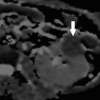Diffusion-weighted imaging in the abdomen and pelvis: concepts and applications
- PMID: 19959522
- PMCID: PMC6939846
- DOI: 10.1148/rg.296095521
Diffusion-weighted imaging in the abdomen and pelvis: concepts and applications
Abstract
Diffusion-weighted magnetic resonance (MR) imaging allows the detection of focal solid and cystic lesions in the abdomen and pelvis and, if pitfalls are to be avoided, is most effectively used in conjunction with other imaging sequences. It is important to recognize that the strength of the diffusion sensitizing gradient (b value) can and should be adjusted to ensure optimal evaluation of the body region or organ being imaged, and that more than one b value is necessary for tissue characterization. The success of lesion detection and characterization largely depends on the extent of tissue cellularity because increased cellularity is associated with impeded diffusion, as indicated by a reduction in the apparent diffusion coefficient. It is also important to recognize that certain normal tissues such as the endometrium are highly cellular and as such demonstrate restricted diffusion, which should not be misinterpreted as disease. Impeded diffusion can also be seen in highly viscous cystic lesions such as abscesses. Diffusion-weighted imaging is an evolving technology with the potential to improve tissue characterization when findings are interpreted in conjunction with findings obtained with other conventional MR imaging sequences.
Figures

























Similar articles
-
Oncologic applications of diffusion-weighted MRI in the body.J Magn Reson Imaging. 2012 Feb;35(2):257-79. doi: 10.1002/jmri.22786. J Magn Reson Imaging. 2012. PMID: 22271274 Review.
-
The role of dynamic contrast-enhanced and diffusion weighted magnetic resonance imaging in the female pelvis.Eur J Radiol. 2010 Dec;76(3):367-85. doi: 10.1016/j.ejrad.2010.01.026. Eur J Radiol. 2010. PMID: 20810230 Review.
-
Principles and applications of diffusion-weighted imaging in cancer detection, staging, and treatment follow-up.Radiographics. 2011 Oct;31(6):1773-91. doi: 10.1148/rg.316115515. Radiographics. 2011. PMID: 21997994 Free PMC article. Review.
-
Diffusion-weighted imaging of the abdomen at 3.0 Tesla: image quality and apparent diffusion coefficient reproducibility compared with 1.5 Tesla.J Magn Reson Imaging. 2011 Jan;33(1):128-35. doi: 10.1002/jmri.22395. J Magn Reson Imaging. 2011. PMID: 21182130
-
Diffusion-weighted MR imaging of the gastrointestinal tract: technique, indications, and imaging findings.Radiographics. 2013 May;33(3):655-76; discussion 676-80. doi: 10.1148/rg.333125042. Radiographics. 2013. PMID: 23674768
Cited by
-
On the dependence of the cardiac motion artifact on the breathing cycle in liver diffusion-weighted imaging.PLoS One. 2020 Oct 1;15(10):e0239743. doi: 10.1371/journal.pone.0239743. eCollection 2020. PLoS One. 2020. PMID: 33002028 Free PMC article.
-
Diffusion-weighted imaging of the liver: usefulness of ADC values in the differential diagnosis of focal lesions and effect of ROI methods on ADC measurements.MAGMA. 2013 Jun;26(3):303-12. doi: 10.1007/s10334-012-0348-1. Epub 2012 Oct 6. MAGMA. 2013. PMID: 23053714
-
Clear Cell Renal Cell Carcinoma Growth Correlates with Baseline Diffusion-weighted MRI in Von Hippel-Lindau Disease.Radiology. 2020 Jun;295(3):583-590. doi: 10.1148/radiol.2020191016. Epub 2020 Apr 7. Radiology. 2020. PMID: 32255415 Free PMC article.
-
[Benign focal hepatic lesions].Radiologe. 2011 Aug;51(8):688-96. doi: 10.1007/s00117-010-2127-1. Radiologe. 2011. PMID: 21809146 Review. German.
-
Quantitative liver lesion volume determination by nanoparticle-based SPECT.Mol Imaging Biol. 2014 Apr;16(2):167-72. doi: 10.1007/s11307-013-0679-y. Mol Imaging Biol. 2014. PMID: 23996677
References
-
- Koh DM, Collins DJ. Diffusion-weighted MRI in the body: applications and challenges in oncology. AJR Am J Roentgenol 2007;188(6):1622–1635. - PubMed
-
- Stejskal EO, Tanner JE. Spin diffusion measurements: spin-echo in the presence of a time dependent field gradient. J Chem Phys 1965;42:288–292.
-
- Patterson DM, Padhani AR, Collins DJ. Technology insight: water diffusion MRI—a potential new biomarker of response to cancer therapy. Nat Clin Pract Oncol 2008;5(4):220–233. - PubMed
-
- Neil JJ. Measurement of water motion (apparent diffusion) in biological systems. Concepts Magn Reson 1997;9:385–401.
-
- Pagani E, Bizzi A, Di Salle F, De Stefano N, Filippi M. Basic concepts of advanced MRI techniques. Neurol Sci 2008;29(suppl 3):290–295. - PubMed
MeSH terms
Grants and funding
LinkOut - more resources
Full Text Sources
Other Literature Sources

